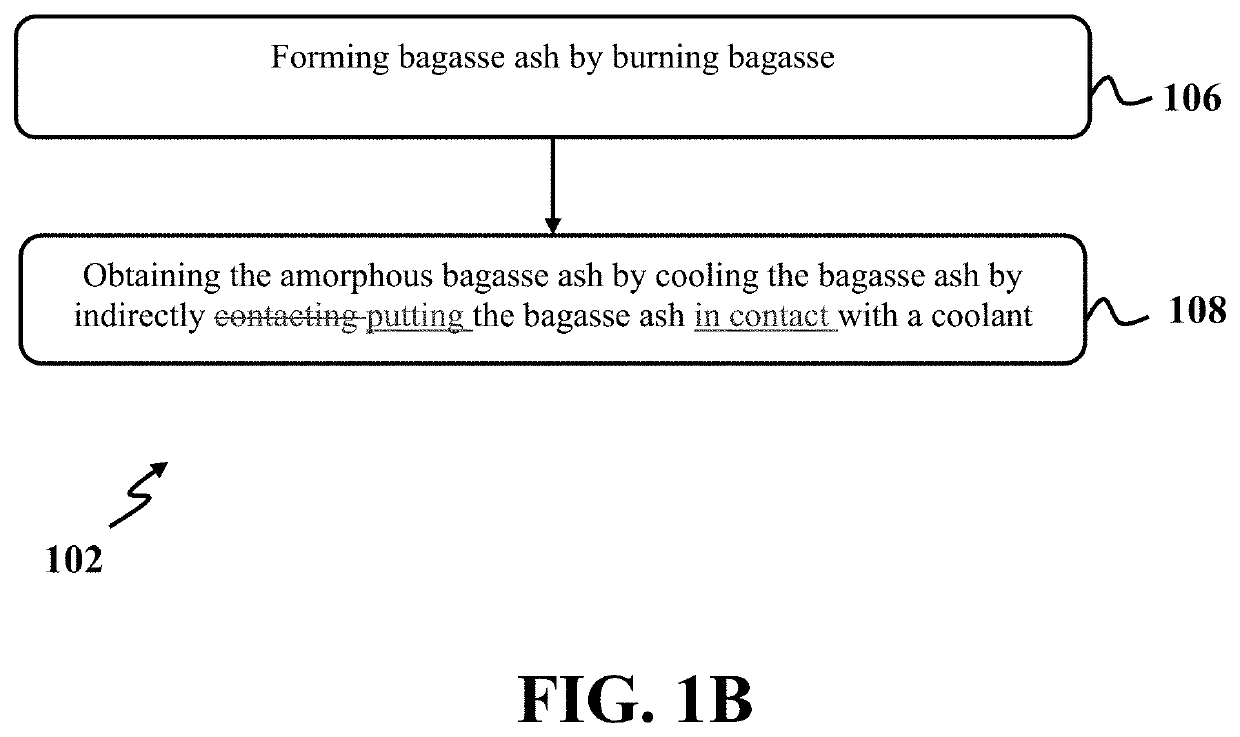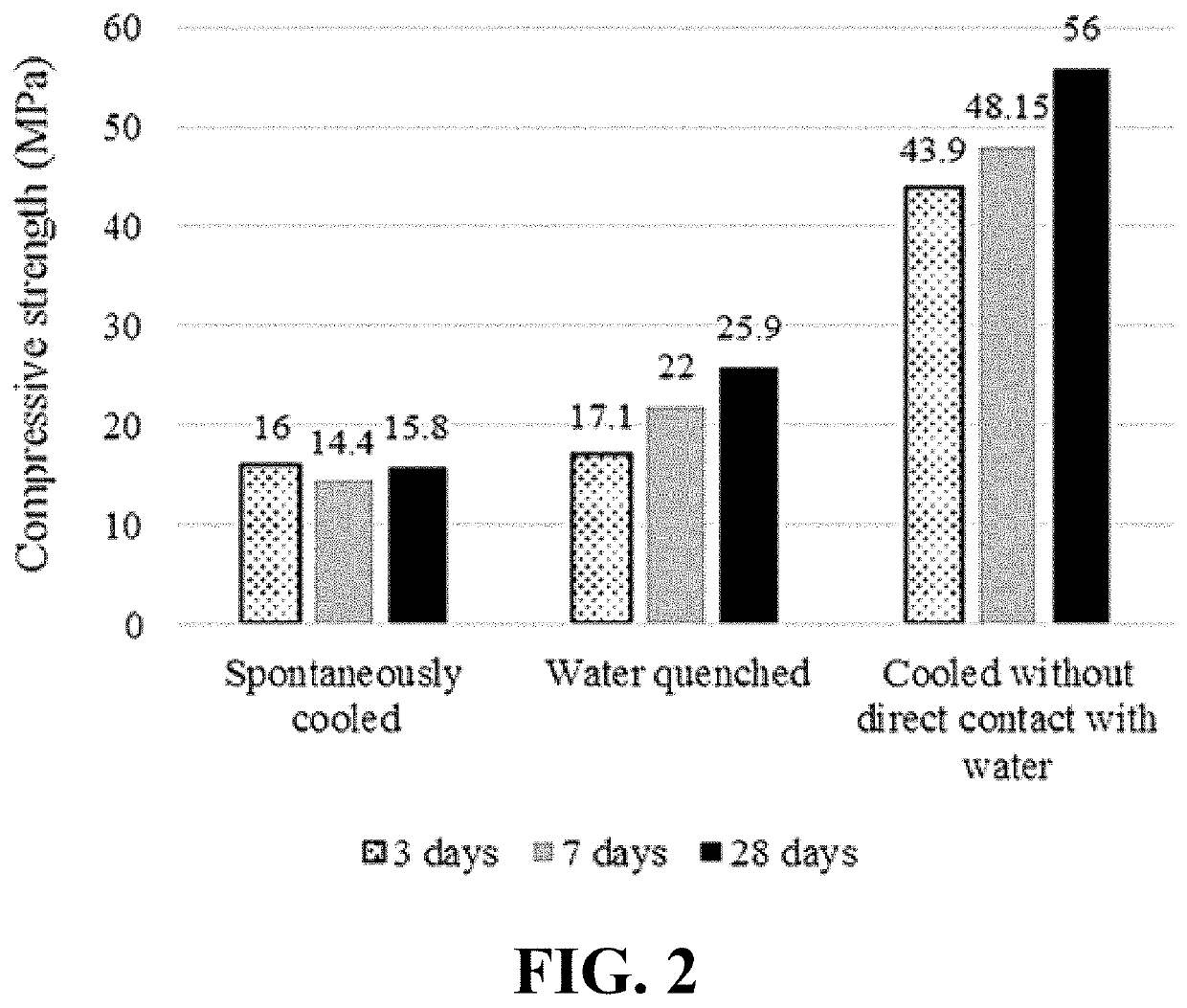Cement compositions based on amorphous bagasse ash
a bagasse ash and composition technology, applied in cement production, solid waste management, sustainable waste treatment, etc., can solve the problems of unsatisfactory compressive strength and chemical resistance, high energy consumption, and use of mineral raw materials
- Summary
- Abstract
- Description
- Claims
- Application Information
AI Technical Summary
Benefits of technology
Problems solved by technology
Method used
Image
Examples
example 1
ve Strength of Cement Compositions Containing Different Types of Bagasse Ash
[0047]In this example, different methods of ash making from bagasse for producing amorphous bagasse ash were examined. At first, bagasse ash was formed by burning bagasse in an electric furnace at a temperature of about 800° C. for a time period of about 2 hours. After burning the bagasse, the bagasse ash was cooled using three different methods including gradual and spontaneous cooling, water quenching, and immediately cooling without direct contact with a coolant.
[0048]In the gradual and spontaneous cooling method, the bagasse is set aside after burning to slowly cool down. However, the resulting bagasse ash obtained using the spontaneous cooling method is completely crystalline with very low reactivity. In the water quenching method, the bagasse ash is poured into the water, or water is sprayed into the bagasse ash. Although the resulting bagasse ash obtained using the water quenching method is slightly m...
example 2
ary High Strength Hydraulic Cement Containing Amorphous Bagasse Ash and Potassium Carbonate (Type 1)
[0053]In this example, an exemplary high strength hydraulic cement composition, named as cement composition type 1, was produced. The exemplary high strength hydraulic cement composition included a dry phase containing potassium carbonate (PC) with a concentration of less than 15% of the weight of the dry phase and an aluminosilicate source containing the amorphous bagasse ash with a concentration between 85% and about 100% of the weight of the dry phase. While water cannot activate the aluminosilicate source containing only the amorphous bagasse ash, concrete formation from the aluminosilicate source containing only the amorphous bagasse ash fails; therefore, potassium carbonate is added to the cement composition for subsequent activation of the amorphous bagasse ash.
[0054]As a result of adding potassium carbonate to the cement composition, whenever water is added to the cement compo...
example 3
ary High-Performance Geopolymer Cement Composition Containing Amorphous Bagasse Ash and an Alkaline Activator Solution (Type 2)
[0061]In this example, an exemplary high-performance geopolymer cement composition containing amorphous bagasse ash and an alkaline activator solution, named as cement composition type 2, is produced. The exemplary geopolymer cement composition included a dry phase containing an aluminosilicate source containing amorphous bagasse ash with a concentration of 100 wt. % of the weight of the dry phase, and a liquid phase containing an alkaline activator solution. However, the alkaline activator solution of the cement composition type 2 differs from the alkaline activator solution of the conventional geopolymer cement compositions which includes a silicate solution. In the alkaline activator solution of the cement composition type 2, a stearate solution is used instead of the silicate solution, which results in high chemical resistance, permeability, and low wate...
PUM
| Property | Measurement | Unit |
|---|---|---|
| weight ratio | aaaaa | aaaaa |
| weight ratio | aaaaa | aaaaa |
| particle size | aaaaa | aaaaa |
Abstract
Description
Claims
Application Information
 Login to View More
Login to View More - R&D
- Intellectual Property
- Life Sciences
- Materials
- Tech Scout
- Unparalleled Data Quality
- Higher Quality Content
- 60% Fewer Hallucinations
Browse by: Latest US Patents, China's latest patents, Technical Efficacy Thesaurus, Application Domain, Technology Topic, Popular Technical Reports.
© 2025 PatSnap. All rights reserved.Legal|Privacy policy|Modern Slavery Act Transparency Statement|Sitemap|About US| Contact US: help@patsnap.com



